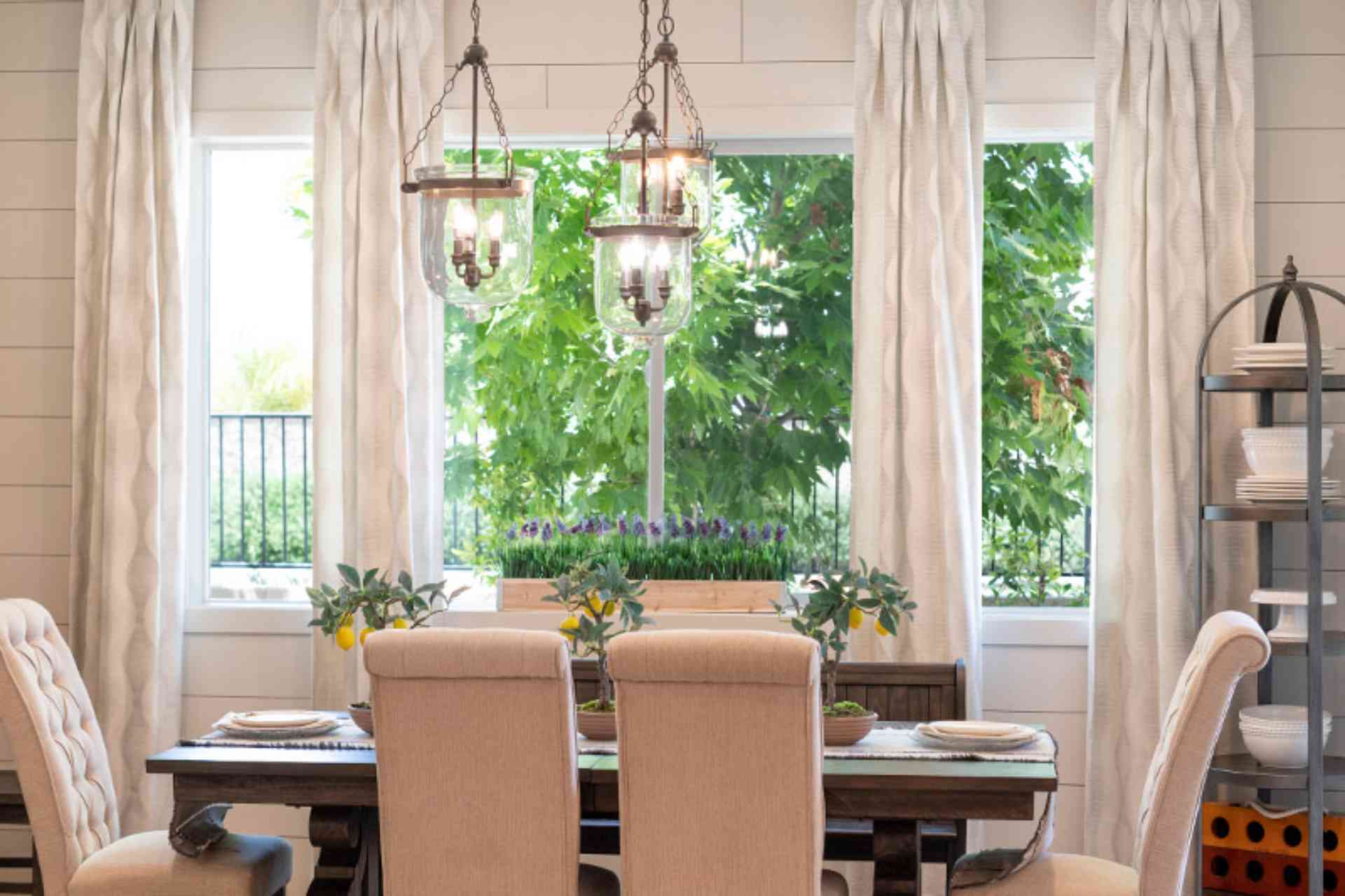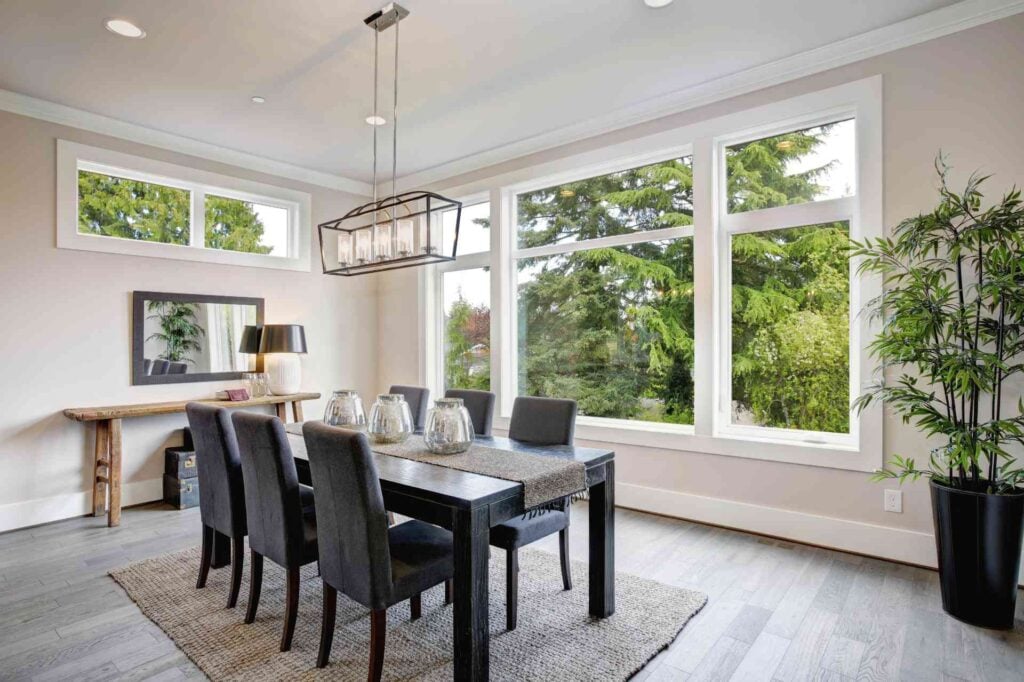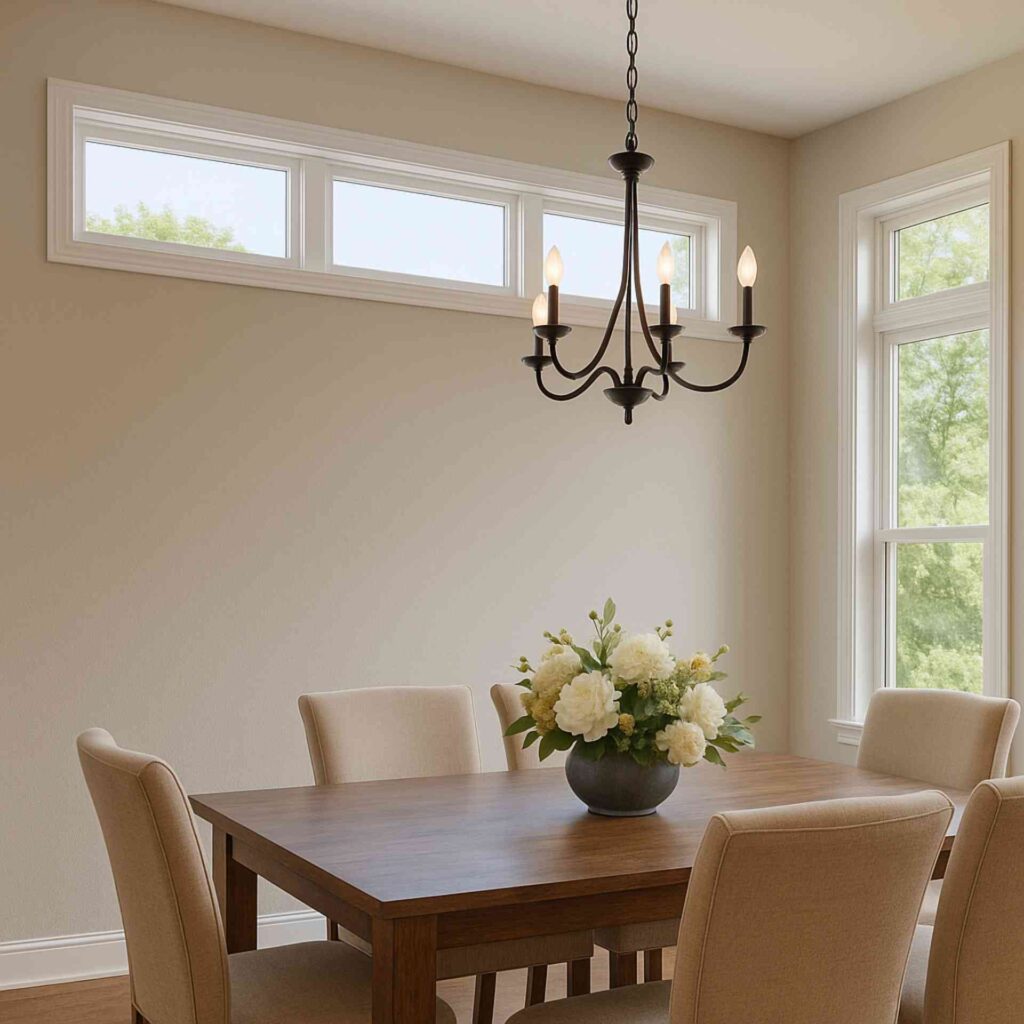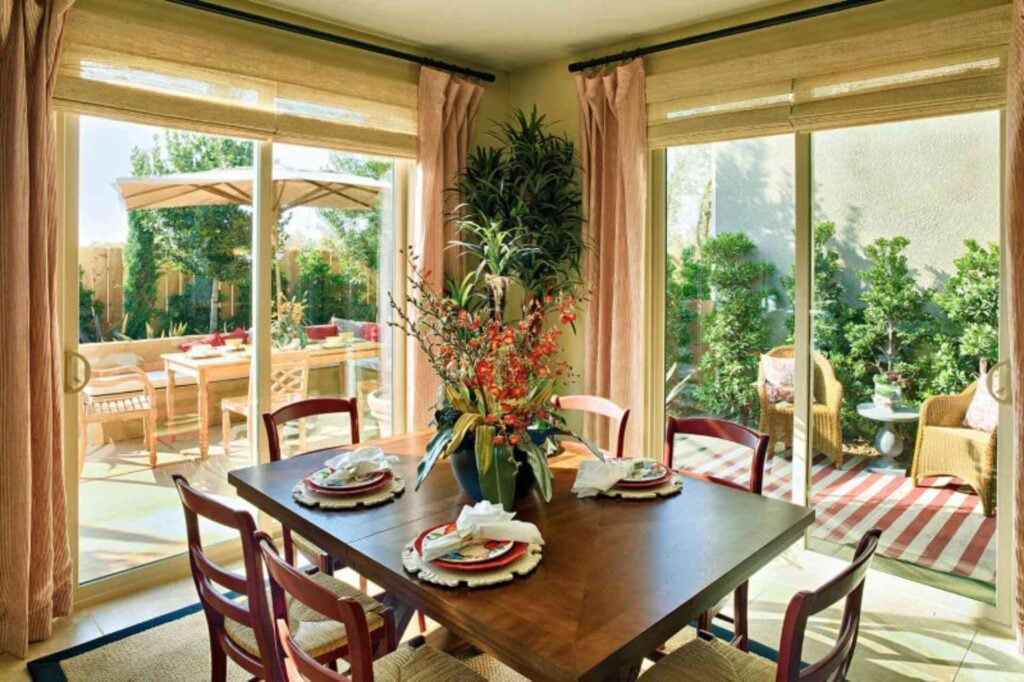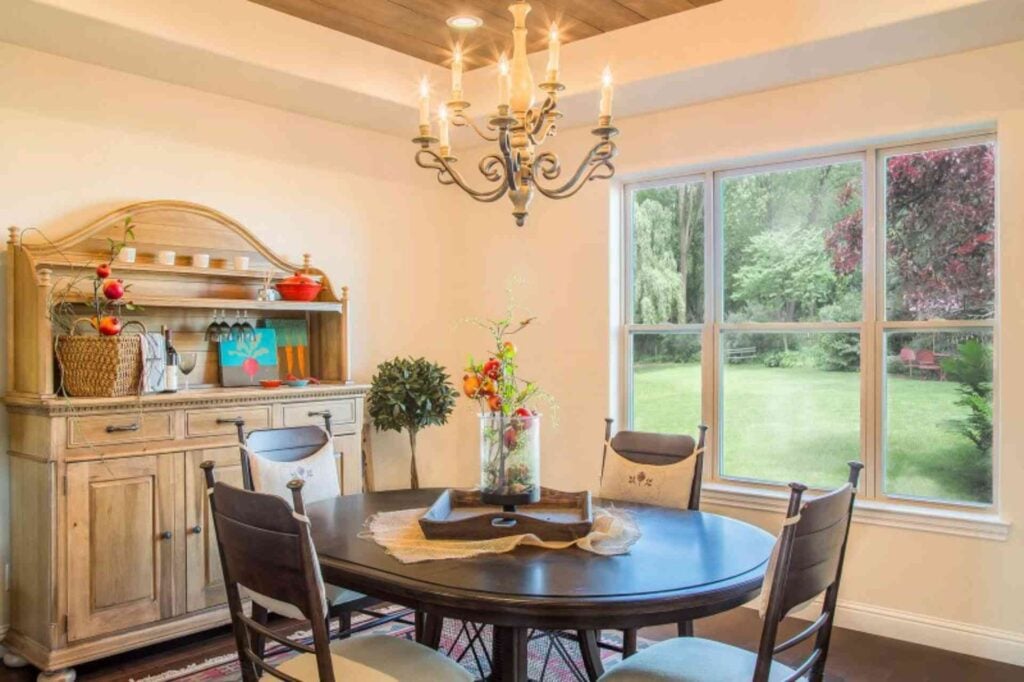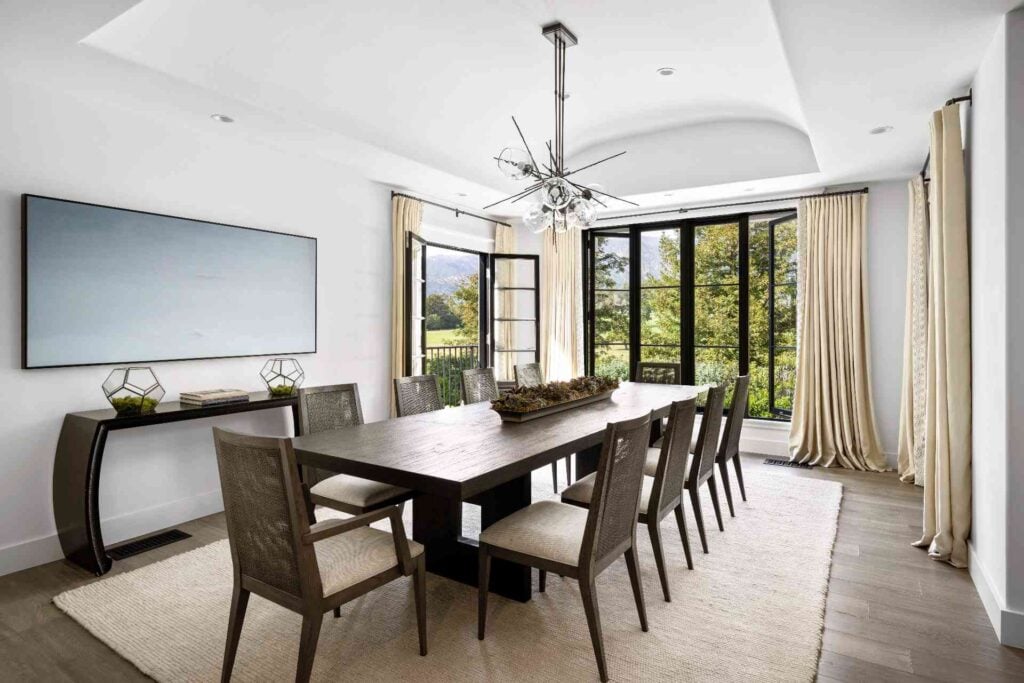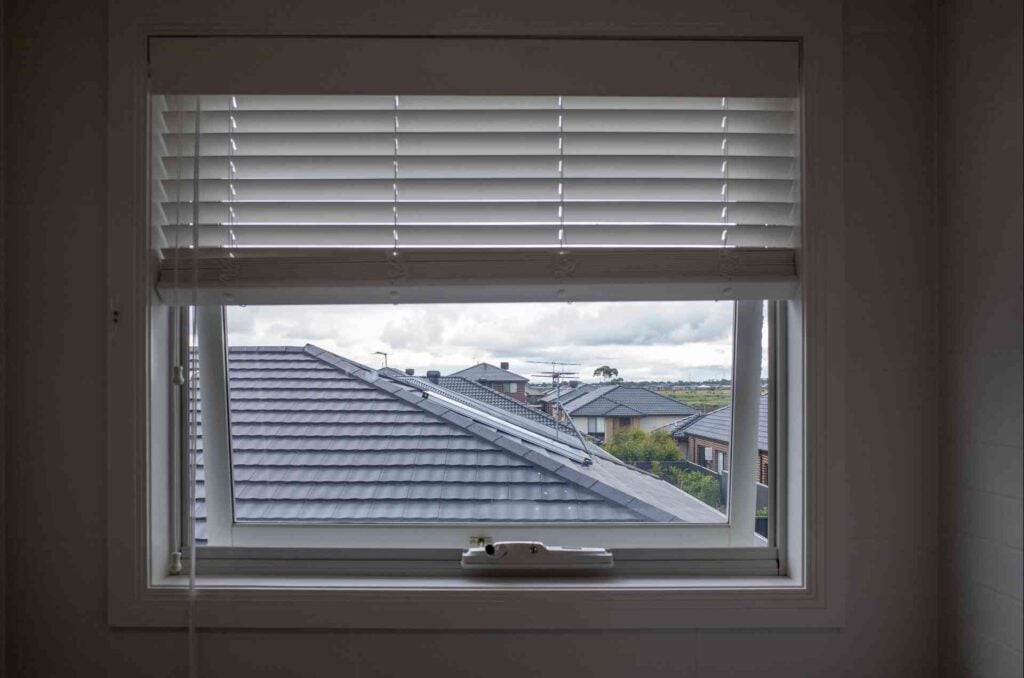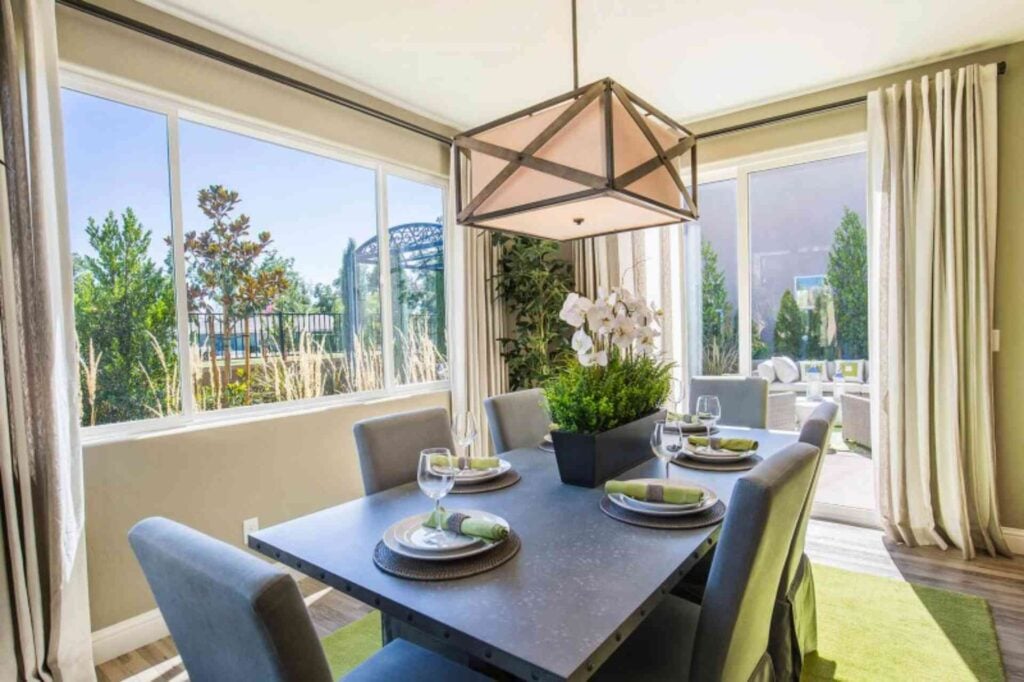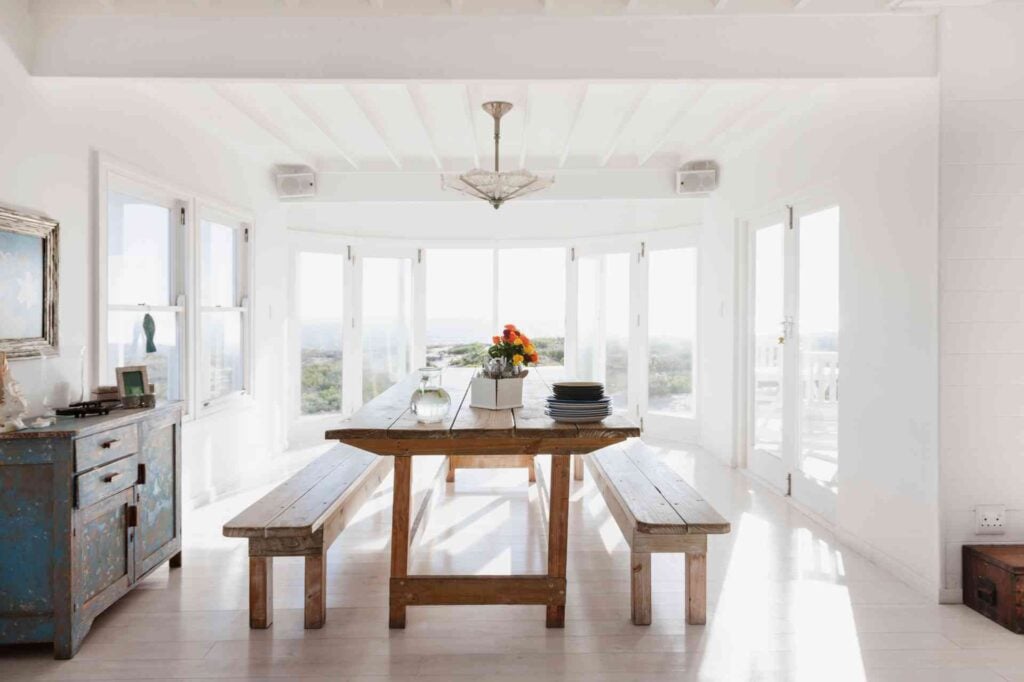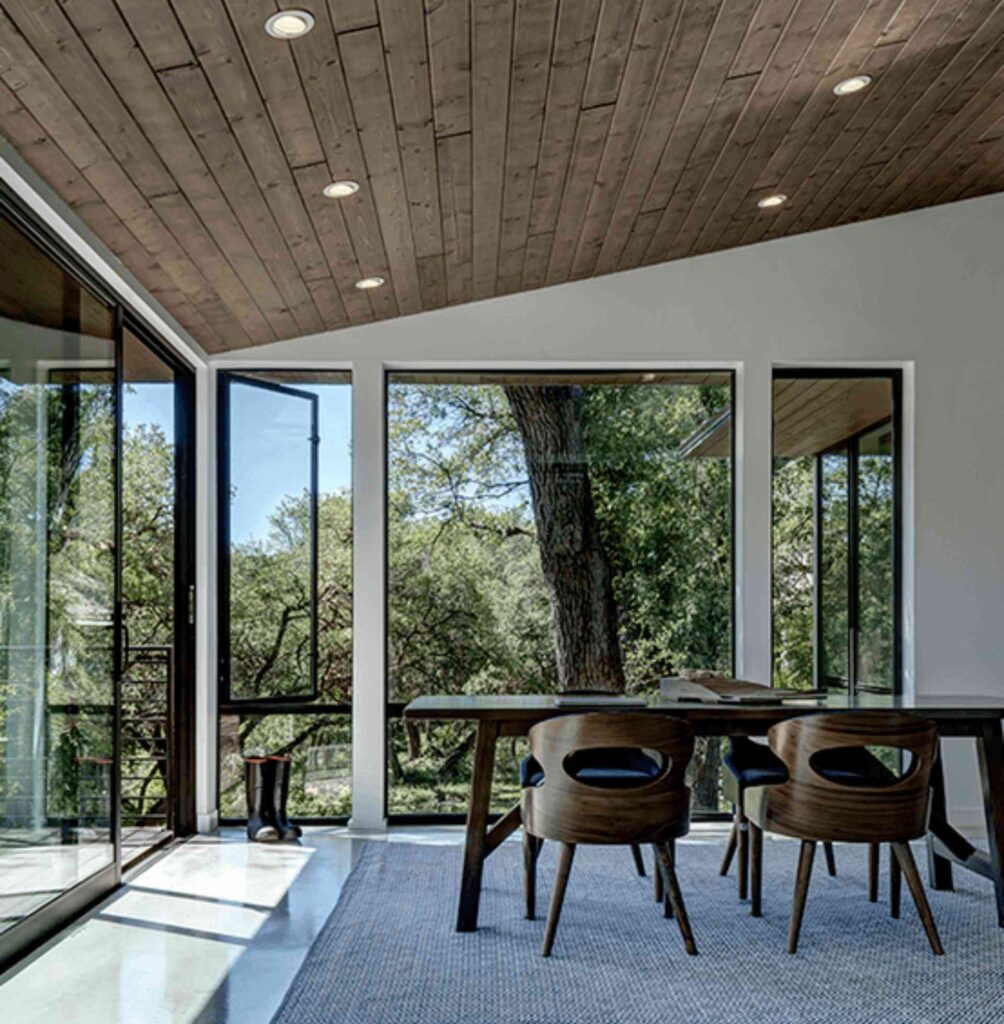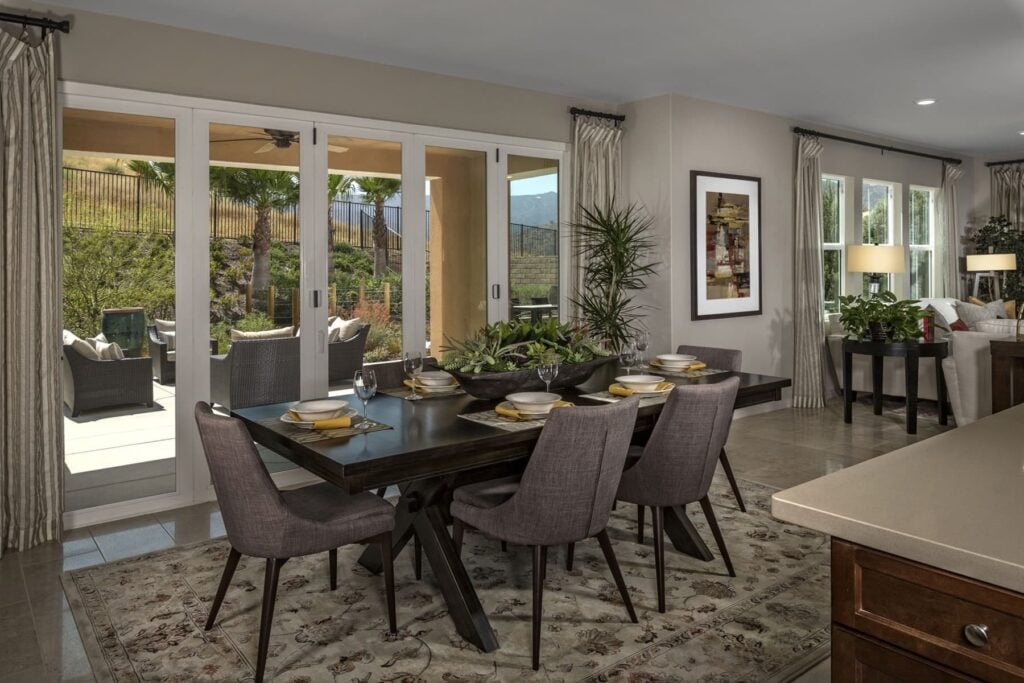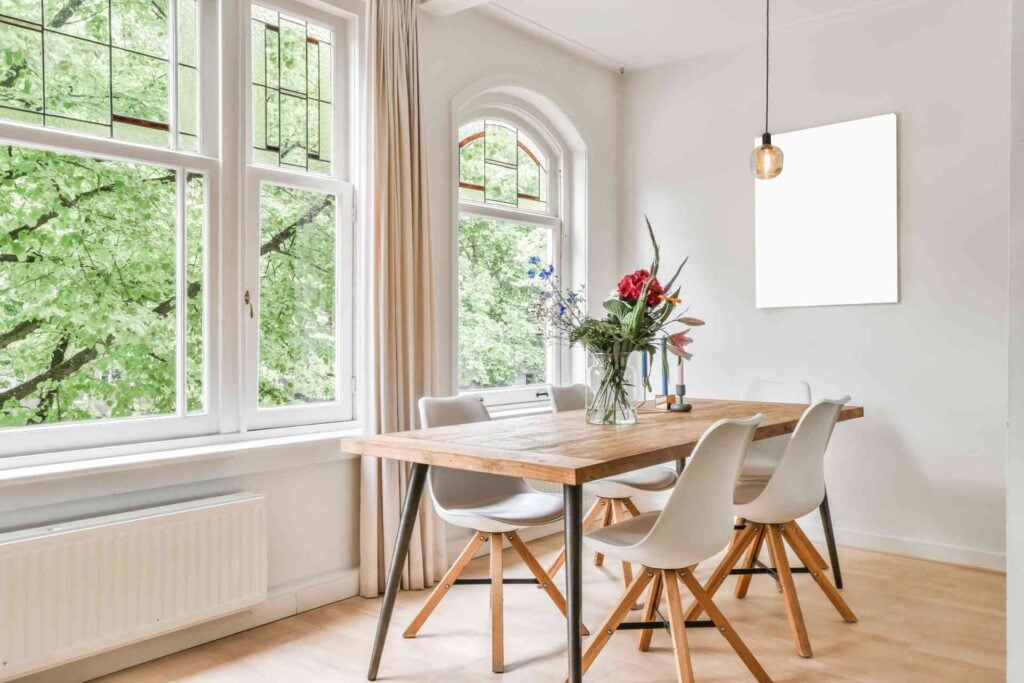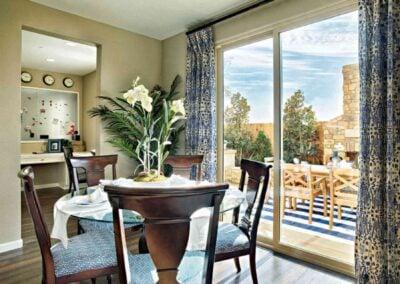Your dining room is one of the few places in your home designed for gathering. Light, views, and atmosphere all play a role in how welcoming it feels, and windows often tie these elements together. The right design can make the room bright and open for daytime meals, or cozy and elegant for evening entertaining. In this guide, we’ll explore various dining room window ideas, focusing on how different styles influence comfort, highlight architecture, and create the perfect backdrop for everyday dinners and special occasions.
Table of Contents
Common Dining Room Window Goals
Before choosing a specific window style, consider what you want your dining room to achieve. Different designs can solve different challenges and create unique experiences. Common goals homeowners have include:
- Maximizing natural light: Many homeowners want their dining room to feel bright and welcoming throughout the day. Larger windows or those with slim frames can flood the space with daylight, reducing the need for artificial lighting.
- Enhancing outdoor views: If your dining room faces a garden, patio, or scenic landscape, the right windows can frame these features as part of the room’s backdrop, making everyday meals feel more connected to the outdoors.
- Creating a cozy or intimate atmosphere: Not every dining room is meant to be bright and open. Smaller windows or designs that filter light can help shape a warm, inviting mood for evening dinners and gatherings.
- Improving airflow and comfort: Ventilation is often overlooked in dining areas. Operable windows allow fresh air to circulate, keeping the space comfortable during warm weather or when entertaining large groups.
- Making a design statement: Windows can serve as architectural focal points. Unique shapes, bay windows, or large expanses of glass can anchor the dining room’s style and complement furniture and décor.
- Connecting with outdoor dining areas: For homes with decks or patios, doors and larger window systems can create a seamless transition between indoor and outdoor spaces, making entertaining more flexible.
Light-Filled Dining Spaces
Natural light is one of the most sought-after features in a dining room. It creates a welcoming atmosphere during the day, highlights interior finishes, and reduces the need for artificial lighting. Whether you’re aiming for a bright breakfast spot or a vibrant gathering space for family meals, the right windows and doors can bring the perfect amount of natural light into your dining room design.
Picture Windows for Breathtaking Views
Picture windows are a great option for homeowners who want to maximize both daylight and scenery. With large, typically fixed panes of glass, they flood the dining room with natural light and provide an unobstructed view of the outdoors. Beyond function, they also serve as a strong design statement, turning the window wall into a focal point that creates a dramatic backdrop, making everyday meals feel more open and connected to nature.
Transom Windows for Added Daylight
Transom windows are most often placed above doors or larger windows, where they draw in extra daylight and add architectural detail while brightening the dining room and giving the wall a more finished, elegant appearance. Transoms can also be used on their own, set higher on the wall to let in natural light without compromising privacy or wall space. In either case, they create a subtle glow from above that can keep the dining room feeling warm and inviting while still connected to the outdoors.
Patio Doors as a Natural Extension
If your dining room is positioned next to a patio, deck, or garden, patio doors are an excellent way to bring the two spaces together. They fill the room with natural light and create a smooth flow between indoor meals and outdoor entertaining, making the dining area feel larger and more versatile.
French patio doors bring a timeless look with side-hinged panels and divided panes, well-suited for traditional or formal dining spaces. Sliding patio doors offer a more contemporary style, using wide glass panels and space-saving operation to highlight outdoor scenery.
Hung Windows for Classic Versatility
Both single- and double-hung windows remain one of the most familiar and versatile options for dining rooms. Their balanced proportions and timeless look make hung windows a natural fit for a wide range of home styles, from traditional to modern. In dining rooms, they provide steady light throughout the day while giving homeowners the option of ventilation when needed. Their classic design also pairs well with other window types, making them an adaptable choice in both new builds and remodels.

Schedule a Free Consultation
Get a free home window inspection, talk with one of our design consultants to get product recommendations, and learn about special offers and financing.
Ventilation-Focused Designs
While natural light is often the first priority in a dining room, airflow plays a key role in overall comfort. Operable window styles can help keep the space feeling fresh, especially during warm weather or when hosting larger gatherings. These designs combine practical ventilation with the opportunity to complement the room’s architecture and style.
Casement Windows for Directional Airflow
Casement windows are hinged on the side and open outward like a door, making them one of the best options for capturing fresh air. In addition to their functionality, casement windows offer a clean, unobstructed view when closed, which makes them a versatile choice for both modern and traditional dining spaces. Positioned near the dining table or along exterior walls, they combine elegance with practicality, ensuring the room feels bright, comfortable, and welcoming.
Awning Windows for All-Weather Ventilation
Awning windows are hinged at the top and can be cranked or pushed open, allowing fresh air to flow in while still shielding the dining room from rain. This makes them especially useful in the Pacific Northwest and other climates where the weather can shift quickly. Their compact design also makes them easy to place higher on the wall, so you can maintain privacy or keep more wall space open for décor while still benefiting from airflow.
They work especially well when combined with larger picture windows, adding ventilation without interrupting expansive views. By balancing light, privacy, and comfort, awning windows create a dining environment that feels both practical and inviting year-round.
Sliding Windows for Easy Operation in Compact Spaces
Sliding windows operate along a horizontal track, making them simple to open and close without taking up any extra space. This makes them especially useful in dining rooms where furniture placement limits clearance for swinging sashes. Their wide glass panels let in plenty of natural light, while the sliding design allows for steady airflow when needed.
With their clean, modern look and practical operation, sliding windows are a versatile choice for both smaller dining areas and open floor plans. They offer an understated style that fits seamlessly into many home designs, providing function without overwhelming the room’s aesthetic.
Architectural Statement Pieces
Some dining rooms are designed to feel simple and understated, while others are meant to stand out. Statement windows bring a strong architectural presence to the space, turning the walls themselves into focal points. These designs add character, depth, and visual interest while still serving practical roles like enhancing light, expanding views, or creating a sense of scale.
Bay Windows for Alcoves and Cozy Seating
Bay and bow windows combine at least three units and extend outward from existing walls, creating a sense of depth that adds both light and dimension to the dining room. The angled design brings in light from multiple directions, making the room feel brighter throughout the day.
In dining rooms, bay and bow windows often create a natural alcove that can be used for seating, a breakfast nook, or decorative displays. This makes them as functional as they are beautiful, adding extra space while becoming a defining architectural feature. Whether paired with a traditional dining set or a more casual arrangement, bay and bow windows create a cozy yet expansive atmosphere that elevates the entire room.
Combination Window Configurations for Balance
Many homeowners choose to pair different window types in the dining room. A popular example is using large picture windows as the main feature, then adding casement or awning windows alongside them for ventilation. Transoms above patio doors or bay windows are another way to bring in extra daylight while creating a layered architectural look.
Combination setups allow you to customize how the dining room feels — open and airy, cozy and private, or a blend of both. They also make it easier to frame the dining table or highlight architectural details by mixing fixed and operable elements. This flexibility makes combination configurations one of the most practical and visually engaging approaches to dining room design.
Stacking Glass Walls for Dramatic Design
Stacking glass walls transform dining rooms by replacing entire sections of wall with glass panels. Unlike standard patio doors, these multi-panel systems create larger openings by sliding and stacking neatly to one side, opening the room completely to the outdoors when desired. Even when closed, they create a striking architectural statement, similar to floor-to-ceiling windows, with expansive views and abundant natural light. For homeowners who entertain often or want a dining room that feels modern and connected to its surroundings, stacking glass walls is a showpiece feature.
Specialty Shapes for Bold Focal Points
Specialty windows break away from standard rectangles and squares, using arches, circles, or custom geometric designs to make a strong visual impact. In a dining room, they can serve as a dramatic backdrop to the table or highlight unique architectural features such as vaulted ceilings or gables.
These windows are often chosen less for function and more for their ability to set the tone of the room. A round or arched window can add elegance and softness, while angular geometric shapes bring a more modern edge. When paired with standard window styles, specialty shapes provide contrast and individuality, turning the dining room into a space that feels custom-designed.
10 Tips for Choosing Dining Room Windows
When it comes time to select dining room windows, the process involves more than just picking a style you like. These practical tips will help you make choices that fit your home and lifestyle:
- Choose the right material: Vinyl and fiberglass are popular material options that offer durability with minimal upkeep, while wood provides warmth and character but requires regular maintenance.
- Decide between fixed and operable: Picture windows maximize light and views but don’t open. Pairing them with casement, sliding, or awning windows ensures both beauty and ventilation.
- Size windows to fit the space: Oversized glass panels can overwhelm a smaller dining room, while too-small windows may undercut a larger space. Proportion is key to balance.
- Plan around furniture placement: Consider how windows interact with the dining table, chairs, and any built-in features. Bay windows, for example, can create a natural seating nook.
- Check clearance for operable windows: Casement and French patio doors need swing room, while sliding designs save space — important in tighter layouts.
- Think about energy performance: Low-E glass, multiple panes, and insulated frames will maintain energy efficiency and keep the dining room comfortable in every season while helping reduce energy bills.
- Coordinate with your home’s style: Match window design to the architecture. Bay, double-hung, and black windows fit traditional homes, while stacking glass walls or slim-frame sliders suit contemporary spaces.
- Layer designs when possible: Transoms above patio doors or picture windows above lower operable windows add variety and dimension while enhancing performance.
- Factor in privacy needs: If the dining room faces a neighbor or street, consider frosted glass, higher window placement, or strategic combinations to balance light and seclusion.
- Set a long-term budget: Factor installation, energy savings, and future maintenance into your decision. A slightly higher upfront cost can pay off in lower utility bills and fewer replacements over time.
Choosing the Right Dining Room Windows
The best windows for your dining room are those that align with your home’s style, boost its curb appeal, support the way you use the space, and deliver comfort year-round. Whether your priority is brightening the room with natural light, creating a focal point with a dramatic design, or ensuring the space stays cozy through every season, the right windows will enhance both everyday meals and special gatherings.
Working with a trusted professional makes the process easier, from selecting the right style and materials to ensuring precise installation. If you’re in the Seattle area, Lake Washington Windows & Doors is here to help. Our team specializes in replacement windows and doors designed for Northwest homes, and every installation is backed by our exclusive Leak Armor Guarantee. Contact us today to schedule your free in-home consultation.




